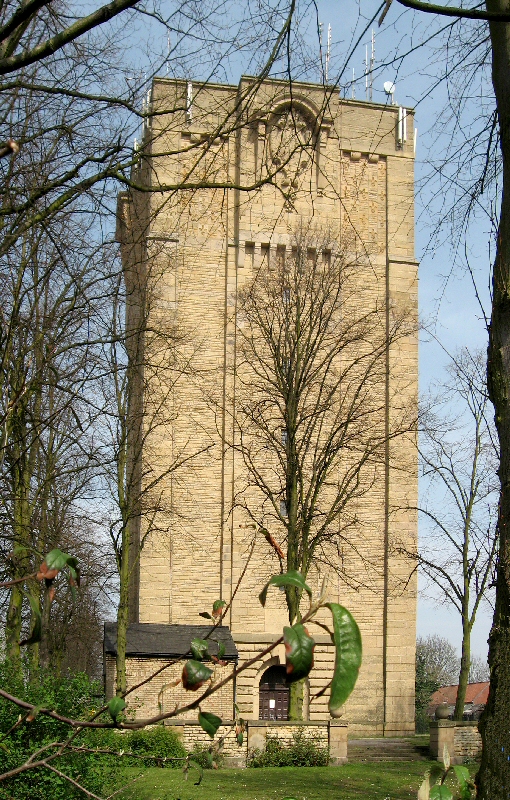
Latest Tweet
Saturday 31 January 2009
Westgate Water Tower, Lincoln

Thursday 29 January 2009
Next BWTAS meeting
 The next BWTAS meeting will be on Thursday 12 February at 7.30 pm at the
The next BWTAS meeting will be on Thursday 12 February at 7.30 pm at theStar Inn, Hall Road, Wenhaston, Suffolk, IP19 9HF (telephone: 01502 478240)
Wednesday 28 January 2009
Redgate Tower, Hunstanton, Norfolk (1912)
 Since water tower conversions seem to be the order of the day, I thought I’d start, with what I hope to be the first of a “fortnightly Ferrers fact” with this tower that has been converted into four luxury flats. Hunstanton Urban District Council, built the Edwardian water tower in 1912 at the south of the town on Redgate Hill, to supply the nearby village of Heacham, where 5 miles of mains were laid. This 50,000-gallon tower is also known as Heacham tower and it’s location provided a top water level of 160 feet. The tower was converted into flats in 1984 and today, a one-bedroom flat changes hands for around £250,000. The tower, grade II listed on 20th September 1984, can be found at O.S. Grid Ref TF 67760 39954.
Since water tower conversions seem to be the order of the day, I thought I’d start, with what I hope to be the first of a “fortnightly Ferrers fact” with this tower that has been converted into four luxury flats. Hunstanton Urban District Council, built the Edwardian water tower in 1912 at the south of the town on Redgate Hill, to supply the nearby village of Heacham, where 5 miles of mains were laid. This 50,000-gallon tower is also known as Heacham tower and it’s location provided a top water level of 160 feet. The tower was converted into flats in 1984 and today, a one-bedroom flat changes hands for around £250,000. The tower, grade II listed on 20th September 1984, can be found at O.S. Grid Ref TF 67760 39954.Hunstanton itself was supplied by a very interesting water tower situated at the water works on the corner of Lincoln Street and Cromer Road. Unfortunately we have no photographs of this Victorian tower that was demolished in the 1970’s. If anyone can help in this respect, please contact us.
Saturday 24 January 2009
The day the music died

Aldershot tower torn down

A 101-year-old popular Aldershot landmark has been demolished after complaints from residents that it was a site for antisocial behaviour.
The Cargate water tower, decommissioned in 2004, was dismantled by South East Water, which is responsible for providing drinking water to the area.
Demolition of the 95ft Edwardian tower, which stood at the Cargate Service Reservoir site in Cargate Terrace, was unanimously agreed by the five members of Rushmoor Borough Council’s cross-party planning committee in February, despite five objections from residents.
Work started on September 15 and was completed by the end of the second week of December.
Reaction to the demolition of the tower, which was clearly visible from as far as the A31 Hog’s Back several miles away, has been mixed. Some are pleased to see the back of the rusting structure, which is said to have been a frequent site for antisocial behaviour, while others are saddened by the loss of a much-loved landmark.
Gordon Percy, of South East Water, acknowledged this, but said the time was right for the tower to go.
“We realise some Aldershot residents were very fond of this local landmark and will be sorry to have seen it disappear from local views, but it was time to let this grand old structure retire after many years of sterling service,” he said.
South East Water spokeswoman Jane Gould pointed out that many of those living in the area were not fond of the tower.
“It was one of those things that wasn’t the most attractive structure but it had been around for so long it was popular to some,” she said.
“People either loved it or hated it. Some were very fond of it and lots saw it as a local landmark but others in the immediate vicinity saw it up close and suggested understandably that it wasn’t the most beautiful structure.”
She added: “We were left with a choice, either to have to keep maintaining it at a cost or to demolish it.”
She also praised the lack of disruption in the tower’s removal and the patience of Cargate residents. South East Water took down the tower by using a grab arm with a reach of 92ft.
Another concrete water tower for sale
 You wait for one to come on the market and then suddenly there's two of them...
You wait for one to come on the market and then suddenly there's two of them... 

Turn this into your dream home for £100,000
The disused structure in Great Doddington is up for sale at a recommended price of £100,000, along with planning permission to convert it into a residential property.
Although it is one of the more unusual properties that estate agent King West of Northampton has dealt with, they say they have already received interest from several potential buyers.
Andrew Kilburn of King West said: "It is not often you see something like this on the market.
"It is going to be a very contemporary property – very individual."
Standing in Cut Throat Lane just outside the village, the building would make an unusual property for a buyer who is prepared to put the work into converting it into a home.
Although the concrete tower looks grey and faceless, the estate agent believes that with windows put in and a roof extension added it could become a trendy 21st century home.
Mr Kilburn said: "You can imagine an artist or someone like that living there. The top floor will be so light and airy.
"It is not going to suit your run-of-the- mill buyer. It is will suit somebody looking for something very individual and a little bit quirky."
Architectural plans show the building could be converted into a four-floor home with an entrance hall, shower and bedroom on the ground floor, a bedroom and bathroom on the first floor, kitchen and dining room on the second floor, and a living room, with an impressive view, on the fourth floor.
Wellingborough Council approved planning permission for conversion of the tower to a single dwelling in September.
Water tower conversions are not unknown, with one red brick example already in existence in Finedon.
- Last Updated: 14 January 2009 8:13 AM
- Source: Northants Evening Telegraph
- Location: Kettering
Friday 23 January 2009
Dereham tower slated for redevelopment
 BWTAS had a enquiry today from the Eastern Daily Press asking for a quote regarding the Victorian water tower (the one on the left of the image) as an application for redevelopment into housing has been made.
BWTAS had a enquiry today from the Eastern Daily Press asking for a quote regarding the Victorian water tower (the one on the left of the image) as an application for redevelopment into housing has been made. The tower at East Dereham was built in 1889, from my research, although the date of 1881 is often quoted. I believe the waterworks was built, despite a "Keep Dereham Dry" campaign - as the residents thought the scheme too expensive.
In 1881 East Dereham¹s original borehole was sunk into the chalk underlying Cemetery Road at a cost of £4,000. By 1889 treatment works had been completed together with a square brick water tower into which the treated water was pumped by a steam engine (³Dereham Past and Present², p32). Before this date, water was obtained from wells or pumps. Most properties had their own but there were three public pumps; in the Market Place near the Assembly Rooms, at the junction of London Road and Baxter¹s Row and in Washbridge (³Looking Back at Dereham, p28, 29 see folder ŒDereham¹²). Located in Cemetery Road, O.S. Grid Ref. TF 99112 14218, Capacity 30,000 gallons.
Notes: The tower appears much as it did originally, but no longer has the penthouse on top of the roof as illustrated in the ³Story of EAST DEREHAM², p66. Grade II listed on 22nd June 1984. IoE #219497.
16.10.09 Sadly the EDP has since removed this story from its website.

